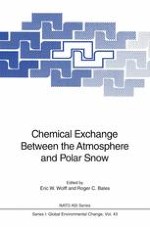1996 | OriginalPaper | Buchkapitel
Interactions of Gas Phase HCL and HNO3 with Ice
verfasst von : Florent Dominé, Emmanuel Thibert, Laurent Chaix
Erschienen in: Chemical Exchange Between the Atmosphere and Polar Snow
Verlag: Springer Berlin Heidelberg
Enthalten in: Professional Book Archive
Aktivieren Sie unsere intelligente Suche, um passende Fachinhalte oder Patente zu finden.
Wählen Sie Textabschnitte aus um mit Künstlicher Intelligenz passenden Patente zu finden. powered by
Markieren Sie Textabschnitte, um KI-gestützt weitere passende Inhalte zu finden. powered by
The analysis of ice cores from polar ice caps has the potential to yield information on the evolution of atmospheric composition during the past 400,000 years (Legrand, 1995). Before such information is obtained, however, we need to understand the relationship linking atmospheric composition to snow composition, i.e. the transfer function. For gases that do not interact with ice, such as CH4, the transfer function is simple, and the CH4 mixing ratio in air bubbles trapped in ice is the same as in the atmosphere (Chappellaz et al, 1990). Gases such as HCl and HNO3, however, interact strongly with ice, and occluded gases contribute to the chloride or nitrate content of ice in a negligible manner. These compounds are then mainly included in the ice volume, but their mechanism of incorporation is not understood. HCl is an indicator of sea salt fractionation. Its mixing ratio yields information on atmospheric transport and acidity. HNO3 is the final stage of oxidation of NOy species. Its determination is useful to understand the NOy budget and the oxidizing capacity of the atmosphere.
